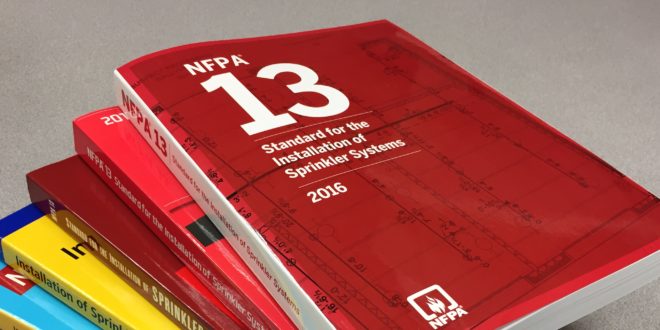Who is Responsible for What?
Everyone knows that a water supply test is simply a snapshot of what is available at that moment in time. We also know that the water supply needs to exceed the system demand of the fire protection system. A final fact is that water supplies can vary over time. There are multiple factors that can impact the available water supply, hereafter referred to as modifiers. What isn’t well known (or more aptly stated what isn’t well implemented) is who is responsible for identifying the water supply and the associated modifiers.
Let’s start with a little historical perspective. Excluding really large jobs, it’s been the sprinkler contractor running down the water supply data and generally speaking everyone ignores the issue of modifiers. It’s always been the responsibility of the owner’s representative (aka the engineer of record) to identify the applicable water supply among other things. For confirmation of this assignment of responsibility, review the position paper titled: The Engineer and the Engineering Technician Designing Fire Protection Systems published in July 2008 as approved by the Boards for the Society of Fire Protection Engineers (SFPE), the National Society of Professional Engineers (NSPE), and the National Institute for Certification in Engineering Technologies (NICET). Unfortunately, just like the sprinkler criteria itself, determining this information has typically defaulted to the contractor. Don’t read into this that we’re saying engineers should be laying out the system, but they should be defining the applicable layout criteria for their building and especially the water supply data. After all, how can they determine whether floor area and associated infrastructure is needed for a fire pump or whether the facility requires a tank, without performing these functions? Now there are some portions of the country that have attempted to remedy this casual behavior with some level of success, but that’s a story for a different time.
There’s also something to be learned from looking at what NFPA 13, Standard for the Installation of Sprinkler Systems, has said about this issue over the last two decades. If you look in the 1996 edition, the working plans were required to provide very specific information about the waterflow test. This requirement has remained in place and is part of the current edition. Additionally, the body of the standard identifies that there are modifiers and that the Authorities Having Jurisdiction (AHJs) may be permitted to require an adjustment. This then changed with the 1999 edition to say the modifiers shall be applied. This information remained in the body until the 2010 edition when it was moved to the annex where it exists to this day (see section A.24.2.2.). So, the current state of affairs is that the body (that being the enforceable portion of the standard), simply says in section 24.2.2.2*: “The volume and pressure of a public water supply shall be determined from waterflow test data or other approved method.”
Before discussing what all this means, let’s first take a look at these modifiers. The older editions of NFPA 13 do a good job of naming them but doesn’t analyze them. Modifiers fall into two categories: those that represent physical changes occurring within the water supply system and those that are arbitrary values assigned to the system. Most physical changes revolve around the available pressure presented by the primary water source. The seasonal concern is evident when water is pulled from a reservoir whose elevation changes significantly between summer and winter. A mere 30-ft drop represents a 13 psi reduction in static pressure. The same thing happens with water tanks with the amount of drop being an operational decision. There’s also the issue of varying local demands on the system, whether it’s the normal average increased flow in the early morning (or late afternoon) in a residential area or large industrial demands (which can be large individual spikes in flow). Since the distribution system is always flowing water, the static reading is actually a residual pressure. As such, large increases in flow reduce the available pressure. These are science-based changes if you will. What’s ignored in this focus on the potential reduction in pressure, is that the water distribution system is typically not a static system. As soon as you introduce a pump into the system, much less multiple pumps acting in a sequential manner, it’s no longer a linear relationship whereby drops in the initial supply mean a drop in the available pressure. A good example of the complexity in systems is when the residual pressure is higher than the static pressure. The water supply systems are domestic sources so are tightly managed systems (to keep the primary users happy). I’m not saying there are no changes to the available supply. I’m trying to point out that it’s rather complicated. There’s also modifiers that are not physically based. Perhaps the thorniest one is being asked to account for future growth and possible degradation. How can you do that with any degree of accuracy or realism? This concern also ignores that these are managed systems. The other primary arbitrary modifier is that assigned by the AHJ. Here, some value, whether a fixed amount or a percentage of reduction, may be assigned in an attempt to account for all the unknown modifiers. Generally speaking, this falls into the “warm and fuzzy” category so we can sleep at night knowing we did something about the possibility that the water supply may be lower than when tested.
Part of a reasonable evaluation of this issue should include a discussion on the relevance of the modifiers (or a better way of saying it is a reality check). Let’s ignore the managed aspect of municipal water supplies and accept that the supply and modifiers are physically based events (aka have a high degree of engineering accuracy). Since accounting for these items could push the curve below the system demand, doesn’t that constitute a potential for failure? Well, the fuzzy part of the issue is the very precise point we call the system demand. The truth is that it has no engineering accuracy because it does not reflect reality. It reflects a very well-defined methodology that allows different parties to arrive at an acceptable layout that we know will control the fire. It’s also very conservative. The size of the remote area is much larger than the one or two sprinklers that control 88 percent of fires for wet pipe systems and 73 percent for dry pipe systems (see U.S. Experience with Sprinklers, by John Hall, June 2013). As such, the flow and pressure of the system demand is much higher than typically needed. Now add on the arbitrarily assigned hose demand and that precise point way out on the curve takes another step away from reality. I’m not saying the methodology is excessively conservative because it reduces the negative impact that can occur when things aren’t exactly as planned. I am saying, let’s not leap to the conclusion that the system will fail if a modifier pushes the water supply curve below the demand point.
There is a need to be more cautious, though, with some systems where the proper identification of the available pressure can impact the performance. In particular, this is for pumps and dry type systems (dry pipe and double interlock preaction systems). Let’s start with pumps since that is the least critical. If the snapshot of your water supply happens to be the lowest possible pressure (which some would call perfect for your system design), higher future pressures could cause you to exceed the maximum allowed pressure when the pump is churning. This is the least critical system because slightly exceeding the pressure rating does not cause failure. I’m not saying to ignore it in your day-to-day designs but I’m trying to paint a realistic picture. The dry type system is a different creature. The time required for water delivery directly impacts the performance of the system. This is addressed by having an explicitly defined maximum interval as part of the system acceptance testing. As such, if you design with a higher operating pressure than available when a trip test is performed, you can have problems. This translates to a reduced level of confidence that a dry type system will control the fire.
Now that we have a clear picture of the issues and the relevance of the modifiers, what does the history of NFPA 13 tell us? This is an issue that has been discussed off and on over a long period of time. What to do about it goes through cycles. The application of modifiers went from being permitted by the AHJ, to being required, to being dropped as a requirement but suggested as Annex material. In the 21 years that I’ve been on NFPA 13, I’m not aware of it being dissected as presented in this article, but many have inherently understood the overall big picture. This cycling of opinion also tells us that it is an issue that would be nice to address, but we aren’t losing any sleep over the fact that it typically isn’t included in the design.
Another aspect of the standard is that some might want to claim that because it is in NFPA 13, that it is the contractor’s responsibility. With no data provided, in order for the job to move forward, contractors have generally accepted the role of identifying the water supply curve (that being where allowed to actually touch the hydrants in order to perform a flow test). The fact that it is part of the shop drawing requirements doesn’t mean it’s the contractor’s responsibility to perform said test. It means they are required to transfer the data from the engineer of record to the AHJ. The presence of modifiers in NFPA 13 has also lead AHJs to expect the contractors to address this issue. The bottom line is that this document provides guidance for both the engineering and the contracting functions. This aspect is confirmed by the birth of the owner’s certificate. It was added to the 2007 edition in an attempt to emphasize that the engineering community has the sole responsibility for some information. It’s by no means an all-inclusive list but acts as a flag that they have a role to play. Since it is such a significant issue, the 2019 edition of NFPA 13 added to the owner’s certificate that the owner or their authorized agent shall provide the water supply information as identified in the water supply chapter (chapter 5 for the new arrangement).
This leads nicely to what other upcoming changes are occurring in NFPA 13. Allow me to point out that it is still in cycle, but unless there is a successful amendment at the annual technical session this summer, here’s the change. The cycle has swung back to saying it shall be addressed. As stated in the new section 5.2.2.2.1*: “Water supply information shall be adjusted to account for seasonal and daily pressure fluctuations based on information from the water supply authority through testing or modeling and as approved by the authority having jurisdiction.”
So once again, it will say the modifiers shall be provided but the onus is on the owner and his agent (that being the engineer of record).
The NFPA 13 technical committee spent a lot of time on this issue, because it was recognized that these modifiers will seldom be provided, there was a strong push to impose an across the board 10 percent reduction, if the water purveyor did not provide the lowest possible pressure. In recognition that municipal water distribution systems are quite complex and a single value does not reflect the reality across the country. The technical substantiation for this change was quite illuminating. It pointed out that certain conditions should be considered or analyzed when determining whether the water supply is adequate. It made an even more poignant point (if these modifiers are ever to be widely applied) by stating: “Safety factors should be the purview of local jurisdictions and where required, adopted into an enforceable code amendment.”
So as a contractor (especially when new to an area), what do you do when nothing is provided? Ask the owner for the water supply data to be used. Then ask the same question of the water purveyor. If you do the water supply test, conclude it by asking the AHJ if they apply a generic safety factor. If it’s a wet pipe system, document that you asked and what you were given, and continue on. If it’s a dry type system, it’s wise to drill a little deeper and ask the water purveyor what the lowest possible pressure that the facility could experience. Again, document it and proceed.
In conclusion, the industry has effectively never incorporated these modifiers. In discussing this issue, there are two main conclusions to be drawn. First and foremost, it is not the contractor’s responsibility to make judgement calls on the water supply. The obvious truth is contractors do not own the water supply, nor do they operate it, maintain it, or insure it. If modifiers are to be applied, it is the water purveyors responsibility to identify them, the engineer of record’s responsibility to provide them, and the AHJ’s responsibility to decide what is to be enforced within their jurisdiction. Secondly, although from a technical standpoint, modifiers can impact the available water supply, from a realistic standpoint (except for possibly affecting the delivery time for dry type system which warrant a little extra effort) it hasn’t been a source of failures. In other words, the issue of modifiers has generally been an academic solution looking for a problem.
ABOUT THE AUTHORS: Roland Huggins, PE is senior vice president of engineering and technical services for AFSA.

He is a graduate of the University of Maryland and a member of the NFPA. Huggins has served on the NFPA Standards Council and is a member of multiple NFPA technical committees, including NFPA 13, NFPA 25, and NFPA 5000 (Building Code). NFPA activities include participating on the editing of the Sprinkler Handbook and Fire Protection Handbook. Other national activities involve the NFPA Research Foundation, UL Standard Technical Panels, and NICET. Huggins is a veteran.

Mike Meehan is president of VSC Fire & Security, Virginia Beach, Virginia. A 1981 graduate from George Mason University in Fairfax, Virginia, he began his fire sprinkler career working summers as a pipe fitter apprentice. Meehan has served on the AFSA Board of Directors since 2008 and currently serves as Region 6 Director.
IMPORTANT NOTICE: The article and its content is not a Formal Interpretation issued pursuant to NFPA Regulations. Any opinion expressed is the personal opinion of the author and presenter and does not necessarily present the official position of the NFPA and its Technical Committee.
 Sprinkler Age A Publication of the American Fire Sprinkler Association
Sprinkler Age A Publication of the American Fire Sprinkler Association
